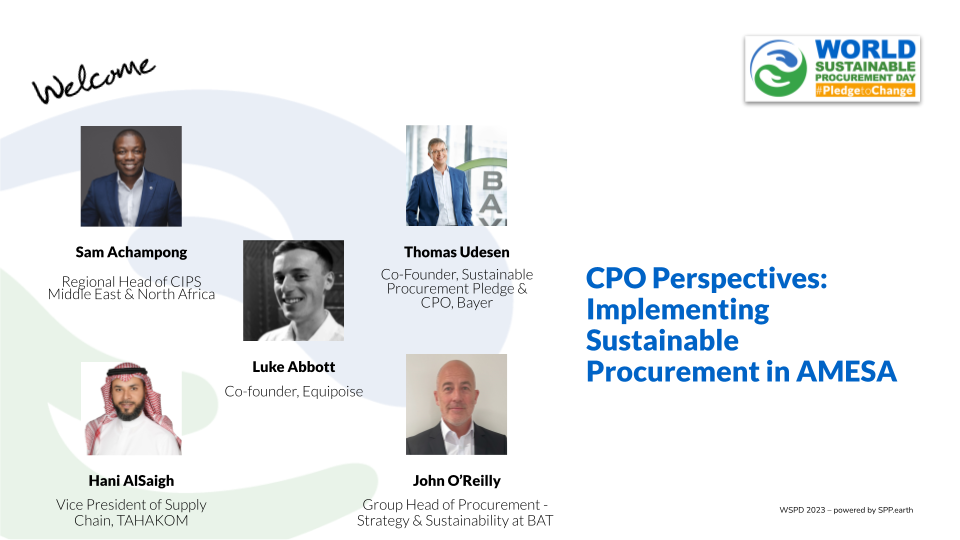WSPD 2023 brought together top CPOs and industry experts from across the globe in a 24-hour-long event, designed to empower and equip Procurement Practitioners with knowledge, best practices, and practical solutions to Sustainable Procurement challenges that need to be tackled NOW.
Broadcasting in 4 different regions, – APAC, AMESA, Europe/UK & the Americas – each session was curated to address the most prominent regional issues surrounding Sustainability in Procurement.
Check out all of the WSPD 2023 sessions here
Kickstarting WSPD 2023 in AMESA, regional CPOs and Thought Leaders;
Sam Achampong (Regional Head of CIPS Middle East & North Africa (MENA)),
Thomas Udesen (CPO, Bayer & Co-Founder, SPP),
Hani AlSaigh (Vice President of Supply Chain, TAHAKOM)
And John O’Reilly (Group Head of Procurement – Strategy & Sustainability at BAT),
were invited to participate in the first session of the region ‘CPO Perspectives: Implementing Sustainable Practises in AMESA’, moderated by Luke Abbott (Co-Founder, Equipoise)
This panel discussion highlighted the challenges, opportunities and priorities facing sustainable procurement practices in AMESA. It was an opportunity for the panellists, as experts and practitioners, to share practical insights into what’s important for the region, what the key priorities are for CPOs, and how procurement practitioners can take action today, in their own organisations.
Here are 4 key insights that our speakers provided across the session:
Sustainability is an investment:
Organisations across the world are constantly looking for progression, especially when it comes to sustainability. But to obtain that progression, Procurement needs to be willing to invest in the right resources, people, and practices.
Thomas Udesen wholeheartedly supported and encouraged investment into sustainable practices, stating “it is an investment that will make you [Procurement] relevant and capable of meeting the requirements of the future”, a resonating sentiment in the face of many looming Carbon Reduction and Net Zero targets.
Explaining the decisions that Procurement has to make in regard to pursuing sustainability, he states that it is “important to remember that if you don’t do it yourself, regulations will creep up on you”. From excessive taxation to fines for violating ethical standards, Thomas’s prediction for the future of procurement and sustainability takes the responsibility of its enforcement out of the hands of procurement professionals and into the hands of others like regional governments.
So according to Thomas, procurement professionals have the choice to either “be the winner” by “[getting] ready now and hav[ing] a more regulated environment”, or “wait until all things come falling down on you and somebody else” will make it for you.
“It is a strategic choice to make. Either you do it now and become really good at it, or you wait and somebody will probably take your market shares” – Thomas Udesen
When contemplating investment within Sustainability, Procurement has often been hesitant due to the high costs. However, Sam Achampong combats this thought, strongly believing that procurement professionals can discover and invest in sustainable sources at commercially viable costs: “I don’t necessarily agree wholeheartedly that sustainable solutions is always a ‘hole in your pocket’”
“We give up too easily”, he exclaimed, strongly advising attendees to “keep looking for that commercial answer to the sustainable solution and I think you’ll find it”, even if that means challenging the cost of ownership components.
“There is always a commercial outcome for your sustainable recommendation” – Sam Achampong
Hani AlSaigh introduced the term, TSCO – ‘Total Sustainability Cost of Ownership’, explaining that Procurement needs to factor in the price of carbon when looking at the overall cost of products/goods. According to him, it is better to favour products of high cost but lower carbon emissions, rather than cheaper products that will have a larger carbon impact.
“We need to have some investment today to save in the future” – Hani AlSaigh
The State of Play in AMESA:
When discussing AMESA, our speakers spoke of the ways it is unique from other regions. From its history, priorities, and actions, it is easy to believe that countries within this region have different sustainability challenges than the rest of the world. This, however, is not true.
“We’re all in the same boat here” – Luke Abbott
Hani explained that the Middle East holds “the same challenges as our colleagues are facing globally”, including Vision 2030 [backlink] and Net Zero by 2060. And with initiatives of planting 10 billion trees in Saudi Arabia and 50 billion trees in the Middle East, it is clear that the “sustainability topic is very important”, not just for organisations but for the local governments as well. Hani goes further to explain how the region itself is “becoming a hot topic” with COP 27 and COP 28 both taking place within the Middle East.
“[There is a] wholehearted acceptance of adoption of new sustainable methods” – Hani AlSaigh
Sam described the Gulf as a “huge region”, that holds “huge characterisations within each area”. He spoke about how the Gulf region is starting their sustainability efforts “from a very different base”, listing their lack of natural resources, and the abundance of non-renewable resources i.e. oil: “This is not a sustainable region in the first place”. However, despite all this, the region has continued to make huge strides towards sustainability, with a push for the diversification of resources, economies and suppliers.
“There is a fast track to creating waves of new industries [and] local sourcing methods which really are driving down the carbon footprint in the first place” – Sam Achampong
Luke Abbott highlighted a common global perspective that “because environmental regulations are not as advanced in these regions, the companies operating in them might not have a strong sustainability profile”. But with reference to his own experience, he lays these perceptions to rest claiming that international companies from regions such as AMESA have “higher sustainability credentials than local companies” due to their ability “to sell and compete on a global stage”.
Education is key
While talking about the challenges Procurement faces with their AMESA suppliers, Hani revealed that there is a “lack of awareness” around sustainability and “why this is very important”, with many suppliers still remaining unaware of “what is sustainability” and “what is ESG”.
And with Procurement’s role of reducing the “80% of carbon emissions” found within Scope 3, Hani believes it is “the responsibility as a procurement professional” to have awareness on topics such as ‘Sustainability’, ‘ESG’, and ‘Scope 3’, for the sake of their team and their suppliers, ultimately aiding in their education in this area.
Luke agreed with the concept of increasing knowledge and awareness amongst procurement professionals, stating that while some may be “passion champions”, “90% of their team will be less aware” of Scope 3 and its impact. Thomas excitedly jumped in, explaining that The Sustainable Procurement Pledge was created for that 90%, helping them to learn more about sustainability challenges and work together to discover a solution.
“Sustainability is so enormous, so complex, so dynamic” that many people do not have easy access to the necessary answers, Thomas claimed. He strongly feels that “amongst our procurement community, we have the answers” but believes that there is “an asymmetry between the ones who know and those who want to know”.
“We just need to fix this asymmetry” – Thomas Udesen
Aside from encouraging everyone to join SPP and “help share your knowledge” with fellow procurement professionals, Thomas also advised attendees to “roll up [their] sleeves” and engage with their supplier network. Those with experience in tackling sustainability challenges should “act as a knowledge broker”, making their experience and resources available to suppliers so that they can capacity build together: “Chances are someone has the answers, so don’t be shy”
“If you want to go fast, go alone. If you want to go far, you go together” – Thomas Udesen
John O’Reilly mentioned that with sustainability efforts being “front and centre”, mandatory learning needs to be integrated within organisations. Ranging from seminars and readings to training platforms, Procurement needs to develop “value beyond saving”, a process where people/suppliers’ “appetite and hunger to learn more and more” is leveraged to make a difference in multiple areas of sustainability and ESG.
“This is a learning journey”, John states, believing that “new best practices” can be found when Procurement opens up discussion and engagement with their suppliers; practices that can subsequently be replicated across several organisations in the future.
“We can really make a difference in all different areas” – John O’Reilly
Sustainability and Procurement should be the same
The terms ‘Sustainability’ and ‘Procurement’ are often discussed as 2 separate entities, with procurement professionals speaking of developing “sustainability policies” as well as “procurement policies”. Sam strongly disagreed with this line of thinking, stating “it should just be a procurement policy with sustainability being intrinsic throughout”. He continues to mention that by separating the 2 elements, “it loses its importance”.
“You can’t put sustainability in a box” – Sam Achampong
According to him, while Procurement and Suppliers are important for the implementation of sustainable practices, it “should come from the top” because “that’s when the real change happens”. When organisation leaders and decision-makers champion sustainability within procurement strategies, only then can these 2 processes be seen as one.
“‘Sustainable procurement’ should not be a word, it should just be procurement but the practices within it should be sustainable” – Sam Achampong
While reflecting on the struggles of embedding sustainability within Procurement, Thomas drew a parallel between this and the Quality Movement that occurred within the 1980s/1990s. Procurement has constantly been asked the question of “who will pay”, whether it is for better quality products or more sustainable goods, and while it has been tough to achieve the desired goal, Thomas states that now it is a “no-brainer”. Thomas ends it with the hope that sustainability will follow a similar evolution, and in 10-20 years the integration of sustainability and sustainable practices within procurement processes will be seen as “the way business is conducted”.
Check out the full panel discussion below to hear more of the panellist’s key insights about implementing sustainable procurement in AMESA.



